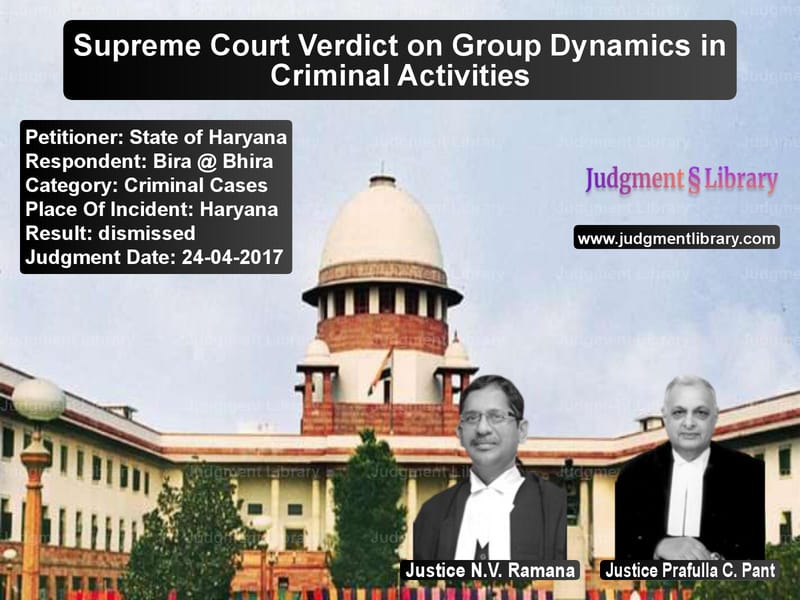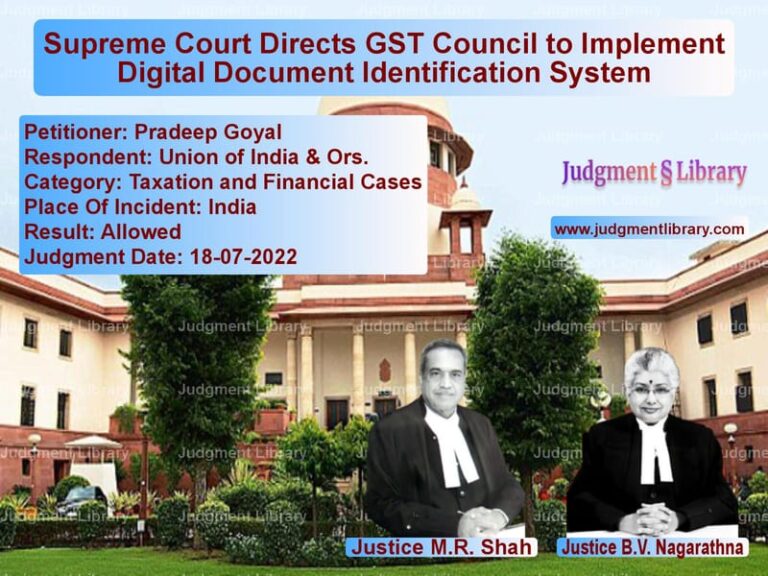Supreme Court Verdict on Group Dynamics in Criminal Activities
The Supreme Court of India delivered a critical judgment in the case of State of Haryana v. Bira @ Bhira, addressing the intricate issues of collective criminal responsibility under Sections 302 and 323 read with Section 34 of the Indian Penal Code (IPC). This landmark judgment clarifies the application of the law regarding group dynamics in criminal activities, particularly in cases involving murder and assault.
The case revolved around the fatal assault on Vakil Singh, who had previously been acquitted in a murder case. The attack was carried out by three men, Sant Lal, Fatta Ram, and Bira @ Bhira. While the trial court convicted all three, the High Court acquitted Bira @ Bhira, leading to appeals by the State of Haryana and by Fatta Ram, the latter seeking to overturn his conviction.
Background
The incident took place in 2005 when Vakil Singh, along with his wife Balbiro, was returning from a condolence visit. They were intercepted by the accused, who were armed and assaulted Vakil Singh, leading to his death. The prosecution alleged that the attack was premeditated and stemmed from previous hostilities related to the earlier murder case involving Vakil Singh.
Supreme Court’s Examination
The Supreme Court scrutinized the evidence and testimonies, particularly focusing on the reliability of the eyewitness accounts from PW-7 Tehla Ram and PW-8 Balbiro, the deceased’s wife, who also suffered injuries during the incident. The apex court found the testimonies credible, supporting the convictions of Sant Lal and Fatta Ram.
However, the court upheld the High Court’s acquittal of Bira @ Bhira, citing insufficient evidence to conclusively prove his participation in the crime. The judgment emphasized the necessity of precise, clear evidence when implicating individuals in crimes committed as part of a group.
Legal Implications
This judgment is significant for its detailed discussion on the principles of collective liability under IPC Section 34. It highlights the importance of distinguishing individual roles in group crimes and ensures that justice is served by accurately identifying the culpability of each participant.
The verdict also sheds light on the procedural aspects of criminal trials involving multiple accused, reinforcing the need for thorough evaluation of all evidence, especially in cases where the death penalty or life imprisonment could be imposed.
Conclusion
The Supreme Court’s decision in State of Haryana v. Bira @ Bhira serves as a vital precedent in cases of collective criminal responsibility, offering clarity and guidance on legal standards necessary to uphold justice in complex criminal proceedings involving multiple defendants.
Don’t miss out on the full details! Download the complete judgment in PDF format below and gain valuable insights instantly!
Download Judgment: State of Haryana vs Bira @ Bhira Supreme Court of India Judgment Dated 24-04-2017.pdf
Direct Downlaod Judgment: Direct downlaod this Judgment
See all petitions in Murder Cases
See all petitions in Attempt to Murder Cases
See all petitions in Theft and Robbery Cases
See all petitions in Judgment by N.V. Ramana
See all petitions in Judgment by Prafulla C. Pant
See all petitions in dismissed
See all petitions in supreme court of India judgments April 2017
See all petitions in 2017 judgments
See all posts in Criminal Cases Category
See all allowed petitions in Criminal Cases Category
See all Dismissed petitions in Criminal Cases Category
See all partially allowed petitions in Criminal Cases Category







